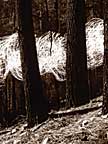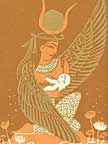|


The Solstice Dream
An exerpt from
The Winter Solstice:
The Sacred Traditions of Christmas
By John Matthews
With contributions by Caitlin Matthews
John and Caitlin Matthews, presenters at Mythic Journeys 2004 and 2006, teach worldwide and are the authors
of more than 70 books primarily about the Arthurian, Celtic, shamanic and spiritual traditions. John's best loved works include
The Celtic Shaman, Healing the Wounded King, and The Winter Solstice. Caitlin's books include
Singing the Soul Back Home, Celtic Devotional, and Sophia, Goddess of Wisdom. They are the
joint authors of The Western Way, The Encyclopedia of Western Wisdom, and The Arthurian Tarot.
The Matthews have given their written permission to quote from The Winter Solstice.
This is copyrighted material and may be reproduced only with written permission.
For information on the U.S. edition of their books, contact
Quest Books,
and for U. K. readers or for more information, their website is
Hallowquest.org.uk.
The photo above shows the Great Passage at New Grange along which the Winter Solstice sunrise brings its
promised rebirth.
Here at the gateway of the year,
May we strive to make good cheer.
In our revels shall joy abound
And sorrow be cast underground.
—Caitlin Matthews from her book Sun Still; Sun Return
It is just before sunrise on a cold December day some three thousand years before the coming of Christ.
For those crouched at the heart of the mound it must seem as though light has been banished forever. Then,
suddenly, a tiny sliver of sunlight strikes the stone slab at the back of the chamber. Slowly it widens, climbs
upward, illuminating a number of mysterious carvings —circles and spirals, zigzag patterns. For the people
crouched in the center of the great mound of Brug na Boine (also known as New Grange) every symbol has
meaning. But by far the greatest significance is the return of the sun itself. The light that enters the dark
womb of the earth brings with it the promise of warmth and life to come.
Darkness and Silence...

It has been celebrated and honored in this way for generations and will continue to be so for many more;
for the celebration of Midwinter, of the demise of the old year and the birth of the new, has always held a deep
fascination for humanity. Long before the coming of Christianity, with which this time of year has become inextricably
linked, people all over the world celebrated the rising of the Midwinter sun and the birth of the gods who held out
to them the promise of a New Year with new hopes. They celebrated in many ways, most often with fire —a
symbol of hope— and with boughs of greenery that symbolized the eternal circle of creation. Images of deities
were restored also, repainted, decorated with special hangings or flowers, a clear indication of the importance of the
season at all levels and in all walks of life. As E.C. Krupp so elegantly puts it in his study of the patterns of ritual and
celebration around the year:
[T]he Winter Solstice was the turning point of time and the birthday of the sun, the moment of new beginnings.
All of nature was poised then to step over the border of the year. When it became the birthday of Christ, Christmas
night became the hinge of the year. It commemorated the timeless moment when heaven...came in contact with
earth, and each year the anniversary...recreated once again the circumstances of that first Christmas. —Krupp:
Beyond the Blue Horizon
(from Chapter 1, pp.11,12)
Return to Passages Menu
|









